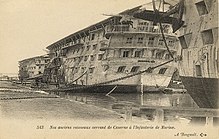Hulk (ship type)
[1] Hulks have a variety of uses such as housing, prisons, salvage pontoons, gambling sites, naval training, or cargo storage.The concept of sheer hulks originated with the Royal Navy in the 1690s, and persisted in Britain until the early nineteenth century.[4] During the wars of the 18th and 19th century, almost every nation's navy suffered from a lack of volunteers[5][6] and had to rely on some form of forced recruitment.The practice was especially common in the age of wooden ships, since the old hulls would remain afloat for many years in relatively still waters after they had become too weak to withstand the rigors of the open ocean.They were used extensively in Great Britain, the Royal Navy producing a steady supply of ships too worn-out to use in combat, but still afloat.Instead, increasingly large numbers of British convicts were held aboard hulks in the major seaports and landed ashore in daylight hours for manual labour such as harbor dredging.[11] The famed clipper Red Jacket ended her days as a coaling hulk in the Cape Verde Islands.The Young America was last seen lying off Gibraltar as a coal hulk; and that superb old greyhound of the ocean, the Flying Cloud suffered a similar ignominious ending.Ever and anon as if to emphasize her newly acquired importance, the tug would bury the old-time square-rigged beauty in a cloud of filthy smoke.Another is the barque James Craig, rescued from Recherche Bay in Tasmania, now restored and regularly sailing from Sydney, Australia.



Hulk (medieval ship type)Toulonpropulsionage of sailfloating cranesailing shipssheersBlocks and tacklemasting sheerboatswainSheernessDuhamel du MonceauMusée national de la MarineHMS MedwayBarracks shipSouverainbarracks shipsC. W. MorsesailorsHMS Temeraireprison hulkreceiving shipvictualling depotguard shipbreakersPrison shipfloating prisonGreat BritainRoyal NavySeven Years' WarNapoleonicFrench Revolutionary WarsAmerican RevolutiontransportedAustraliaRoyal Naval DockyardBermudagunpowderclipper shipsbargesRed JacketYoung AmericaNew Havensquare-riggedanchorspontoonsship graveyardMuseum of London ArchaeologyThames Discovery ProgrammeNautical Archaeology Societyfloating production storage and offloadingKnock NevisTI-class supertankersScuttlingblockshipbreakwaterartificial reefgambling shipmuseum shipJohanna SmithbarquePolly WoodsideJames CraigRecherche BayTasmaniaBritannia Royal Naval CollegeMoored training shipBrown, Henry CollinsCeremonial ship launchinglists by yearShip commissioningReserve fleetShip breakingShip-Submarine Recycling ProgramRetrofittingTarget ship

